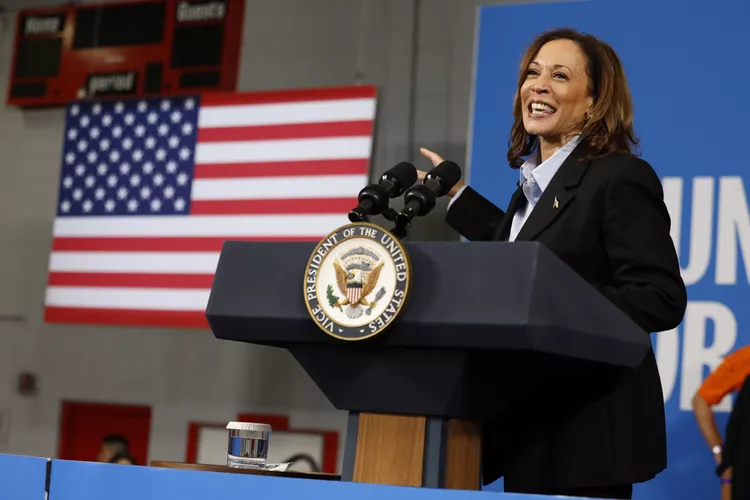Kamala Harris’s Economic Plan: A Roadmap for the Future
Kamala Harris’s economic plan, unveiled during her presidential campaign, aimed to tackle pressing issues affecting middle- and working-class families, such as affordable housing, high prescription drug costs, and income inequality. While her plans shared similarities with Bidenomics, there were key differences that set her agenda apart.
READ ALSO:
National Debt Showdown: Democrats vs. Republicans
Key Components of Harris’s Economic Plan
– Revising the Tax Code: Harris proposed a tax code overhaul to reduce the burden on middle- and working-class families.
– Lowering the Cost of Living: Her plan aimed to decrease the cost of everyday items, making life more affordable for Americans.
– Addressing Income Inequality: Harris sought to bridge the income gap by promoting economic growth and job creation.
Housing Affordability: A Top Priority
Harris’s plan included:
– Constructing 3 Million New Housing Units: To ease the housing supply shortage and provide affordable options for Americans.
– Tax Incentives for Homebuilders: Encouraging homebuilders to construct starter homes for first-time homebuyers.
– $40 Billion Innovation Fund: Supporting local governments in finding innovative solutions to housing shortages.
– Down Payment Support and Tax Credits: Providing $25,000 in down payment support for eligible first-time homeowners and a $10,000 tax credit.
READ ASLO:
Governments’ profound influence on markets: Understanding the complex relationship
Additional Key Proposals
– Lowering Prescription Drug Costs: Capping insulin costs at $35 and out-of-pocket expenses for prescription drugs at $2,000.
– Canceling Medical Debt: Working with states to cancel medical debt for millions of Americans.
– Banning Price Gouging: Preventing grocery chains from price gouging and eliminating taxes on tips.
Harris’s economic plan offered a comprehensive approach to addressing the nation’s economic challenges. While her presidential campaign may be over, her proposals continue to contribute to the ongoing conversation about America’s economic future.
EXCERPT
MAKE A LONG NEWS What Kamala Harris’s Economic Plan Could Have Meant for Your Future
Detailing the key components and potential impact of her economic plan and what it could’ve meant for the futureBy Mallika Mitra Updated January 27, 2025
Reviewed by Samantha Silberstein
Fact checked by Vikki Velasquez
Vikkie Velasquez
Fact checked by Vikki Velasquez
Full BioVikki Velasquez is a researcher and writer who has managed, coordinated, and directed various community and nonprofit organizations. She has conducted in-depth research on social and economic issues and has also revised and edited educational materials for the Greater Richmond area.
Learn about our editorial policies
US Vice President and Democratic presidential candidate Kamala Harris speaks at a Labor Day event at Northwestern High School in Detroit, Michigan, September 2, 2024.
Kamala Harris in Detroit, Mich., Sept. 2, 2024.
Jeff Kowalsky / Getty ImagesFormer presidential candidate Kamala Harris’s economic plan included policies aimed at lowering the cost of living for middle- and working-class families, creating opportunities for economic growth in underserved communities, supporting social service programs, and more. However, while Harris’s plans overlaped with aspects of Bidenomics, there were also key differences.
Key Takeaways
Kamala Harris’s economic plan included revising the tax code, lowering the cost of living, and addressing income inequality.
Harris’s economic plan aimed to support middle—and working-class families, focus on job creation, and increase economic growth overall.
The former presidential candidate originally faced criticism for a lack of clarity around her specific plans.
Key Components of Kamala Harris’s Economic Plan
The Harris-Walz campaign said it’s focus is “building up the middle class.” Harris said she would cut taxes, lower costs for everyday items, create jobs, and grow the economy. She has also said “I am a capitalist. I believe in free and fair markets.”Cost of Housing
Lowering the cost of housing—an issue that is top of mind for many Americans as home prices reach a record high—was a key component of the Kamala Harris plan.Her campaign called for the construction of three million new housing units to ease the housing supply shortage across the country. The former presidential candidate also planned to implement a tax incentive for homebuilders who build starter homes that are sold to first-time homebuyers and to propose a new $40 billion innovation fund to support local governments in finding solutions to housing shortages. Her agenda mentioned taking action to make certain federal lands eligible to be repurposed for affordable housing.
Harris said she would provide $25,000 in downpayment support for all eligible first-time homeowners while ensuring full participation by first-generation home buyers and a $10,000 tax credit for first-time home buyers.
The Harris-Walz administration said it would have called on Congress to pass two bills related to renting. The first is the Stop Predatory Investing Act, a bill introduced in 2023, which would have removed tax benefits for investors owning 50 or more single-family homes to rent, and the second is the Preventing the Algorithmic Facilitation of Rental Housing Cartels Act, a bill introduced in 2024 to crack down on companies inflating rental prices.
3Harris’s plan also included lowering the cost of prescription drugs and the burden of medical debt. The former presidential candidate said she would do this by capping the cost of insulin at $35 and out-of-pocket expenses for prescription drugs at $2,000. She also said she would allow Medicare to speed up negotiations so drug prices can come down faster and to work to stop pharmaceutical companies from blocking competition. Building on her work as vice president, the candidate said she would have worked with states to cancel medical debt for millions of people.
Harris also proposed a ban on price gouging from grocery chains and an end to taxes on tips.
Source: Investpedia





